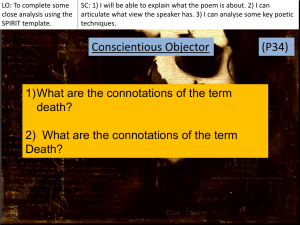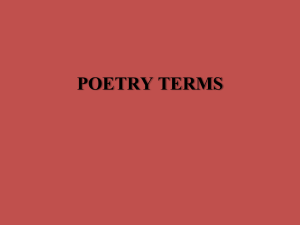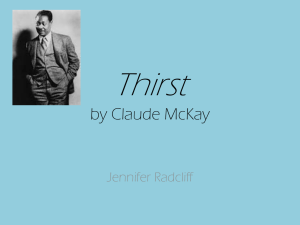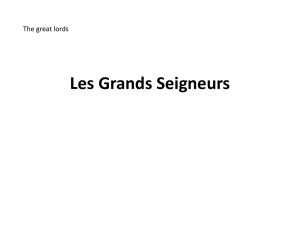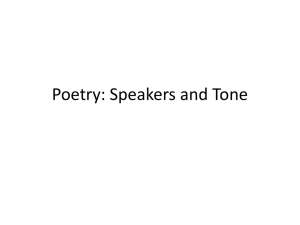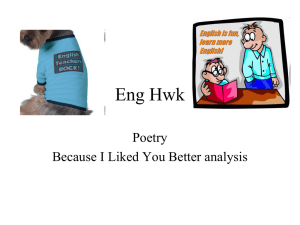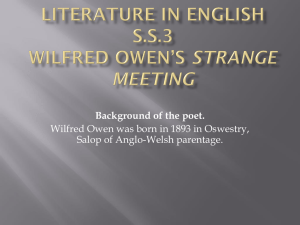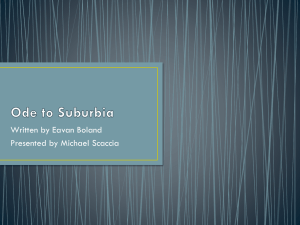Cousin-Kate - WordPress.com
advertisement
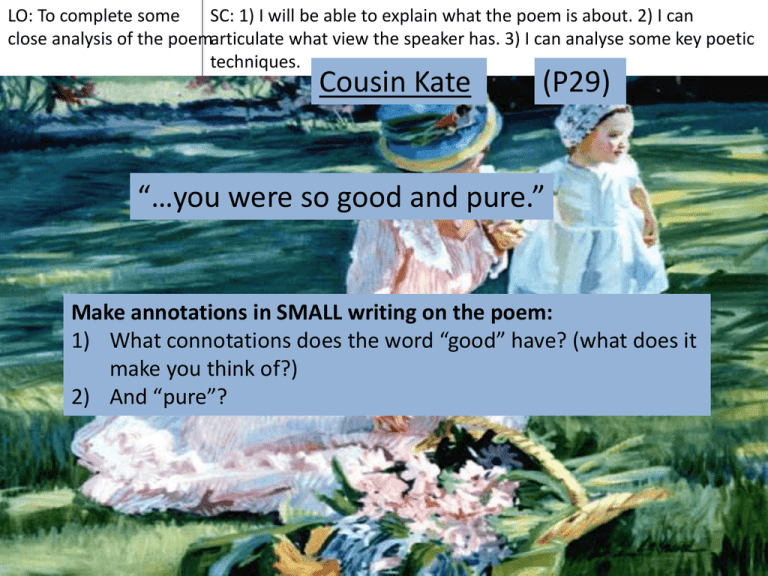
LO: To complete some SC: 1) I will be able to explain what the poem is about. 2) I can close analysis of the poemarticulate what view the speaker has. 3) I can analyse some key poetic techniques. Cousin Kate (P29) “…you were so good and pure.” Make annotations in SMALL writing on the poem: 1) What connotations does the word “good” have? (what does it make you think of?) 2) And “pure”? LO: To complete some close analysis using the SPIRIT template. SC: 1) I will be able to explain what the poem is about. 2) I can articulate what view the speaker has. 3) I can analyse some key poetic techniques. Christina Georgina Rossetti (5 December 1830 – 29 December 1894) was an English poet who wrote a variety of romantic, devotional, and children's poems. Many scholars have identified feminist themes in her poetry. She was opposed to slavery, cruelty to animals and the exploitation of girls in under-age prostitution LO: To complete some close analysis using the SPIRIT template. SC: 1) I will be able to explain what the poem is about. 2) I can articulate what view the speaker has. 3) I can analyse some key poetic techniques. Poetic Devices 1) From what perspective is the poem told? What does this tell us about the power that the speaker has if she is nameless? Structure 4) What does the repetition of the question mark tell us about the narrator? Poetic Devices 2) “Cottage maiden” is juxtaposed with “great lord,” why? I was a cottage maiden Hardened by sun and air Contented with my cottage mates, Not mindful I was fair. Why did a great lord find me out, And praise my flaxen hair? Why did a great lord find me out, To fill my heart with care? Imagery 3) Look at “contented” and “not mindful”. Is the language active or passive? What does this tell us about the power held by women in Victorian England? LO: To complete some close analysis using the SPIRIT template. SC: 1) I will be able to explain what the poem is about. 2) I can articulate what view the speaker has. 3) I can analyse some key poetic techniques. Imagery Poetic Devices 1) What does the word “lured” tell us about the lord? 3) Why has the poet used the oxymoron “shameless shameful life” to describe the narrator? Imagery 2) Annotate the 2 similes in this stanza. What do they tell us about the lord? He lured me to his palace home Woe's me for joy thereofTo lead a shameless shameful life, His plaything and his love. He wore me like a silken knot, He changed me like a glove; So now I moan, an unclean thing, Who might have been a dove. Imagery 4) What is “unclean thing” a reference to? LO: To complete some close analysis using the SPIRIT template. SC: 1) I will be able to explain what the poem is about. 2) I can articulate what view the speaker has. 3) I can analyse some key poetic techniques. Imagery 4) This poem is full of contrasts – label two in this stanza and explain why the poet uses so many. Imagery 1)How would you describe the language in this stanza (and the rest of the poem)? Simple, complex? How many syllables do lots of the words contain? What effect is created by the language? O Lady Kate, my cousin Kate, You grew more fair than I: He saw you at your father's gate, Chose you, and cast me by. He watched your steps along the lane, Your work among the rye; He lifted you from mean estate To sit with him on high. Imagery 2) How do the underlined phrases make the lord sound? A B A B C B A B Rhyme 3) Label the rhyme scheme in this stanza. Is it regular or irregular in the poem? What effect does this create? LO: To complete some close analysis using the SPIRIT template. Poetic Devices 1) Why is the underlined phrase repeated? What does it highlight about the narrator’s feelings? SC: 1) I will be able to explain what the poem is about. 2) I can articulate what view the speaker has. 3) I can analyse some key poetic techniques. Because you were so good and pure He bound you with his ring: The neighbors call you good and pure, Call me an outcast thing. Even so I sit and howl in dust, You sit in gold and sing: Now which of us has tenderer heart? You had the stronger wing Imagery 2) a) In contrast, what do “the neighbours” call the narrator? b) What connotations do these two words contain? c) What does this tell us about Victorian attitudes to love and marriage? Imagery 3) “howl in dust” is an example of vivid imagery; annotate the two words on your poem. We will discuss connotations afterwards. Ideas 4) What themes and ideas does Rossetti convey in this poem? LO: To complete some close analysis using the SPIRIT template. SC: 1) I will be able to explain what the poem is about. 2) I can articulate what view the speaker has. 3) I can analyse some key poetic techniques. Tone / Voice 1) Who is the narrator addressing for much of the poem? How would you describe her tone of voice? O cousin Kate, my love was true, Your love was writ in sand: If he had fooled not me but you, If you stood where I stand, He'd not have won me with his love Nor bought me with his land; I would have spit into his face And not have taken his hand. NOTE: The lord in this poem is not reproached for the way he behaves, whilst the narrator is. Imagery 2) This is a vivid image. What does it tell you about the way the narrator feels? Poetic Devices 3) What tense is the underlined quotation written in? What does this tell you about the power available to women in Victorian society? LO: To complete some close analysis using the SPIRIT template. SC: 1) I will be able to explain what the poem is about. 2) I can articulate what view the speaker has. 3) I can analyse some key poetic techniques. Imagery 1) What is “gift” a metaphor for? Tone / Voice 2) This stanza symbolises a shift in tone and mood for the narrator – how is this reflected in the line “I’ve little doubt you fret”? Yet I've a gift you have not got, And seem not like to get: For all your clothes and wedding-ring I've little doubt you fret. My fair-haired son, my shame, my pride, Cling closer, closer yet: Your father would give his lands for one To wear his coronet Poetic Devices 3) What does the alliteration tell us about the speaker? LO: To complete some close analysis using the SPIRIT template. Area of analysis Structure Poetic devices Imagery Rhythm/rhyme Ideas Tone/voice SC: 1) I will be able to explain what the poem is about. 2) I can articulate what view the speaker has. 3) I can analyse some key poetic techniques. Techniques within this area Layout, stanza shape, punctuation Repetition, personification, onomatopoeia, alliteration, assonance, any non-standard English Similes, metaphors, language choice. Rhyme scheme, rhythm, assonance, alliteration Themes and messages. The character of the persona (the person speaking in the poem, NOT the poet) Overall tone or mood and how this is conveyed. You now have 10 minutes to do the following: 1. Use 1 piece of A4 lined paper and create a SPIRIT grid. 2. Put the letter in the margin 3. Add notes what of you have observed about the poem to each column Tips! Use your annotations from your anthology to help you. Don’t write in full paragraphs – the point is to get quick, important notes down By the end of this term you will be able to do this in 5 minutes!
